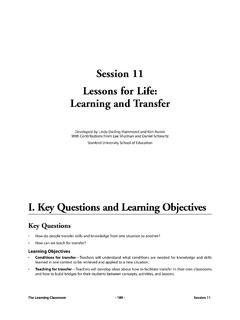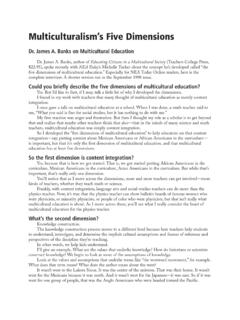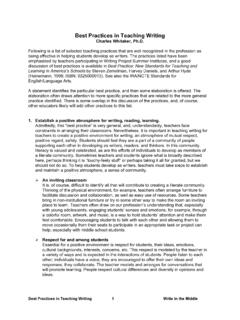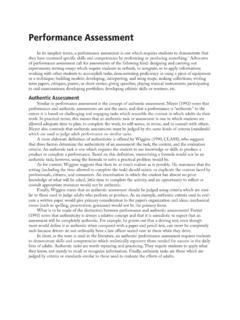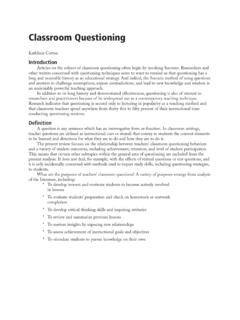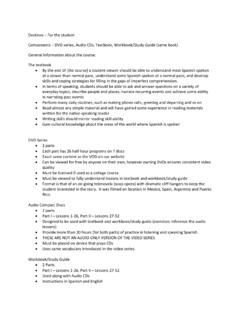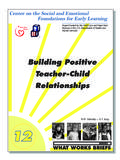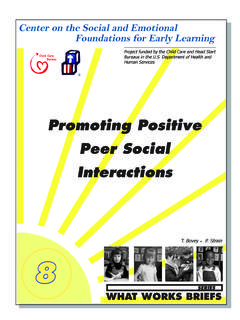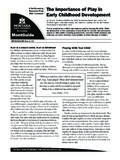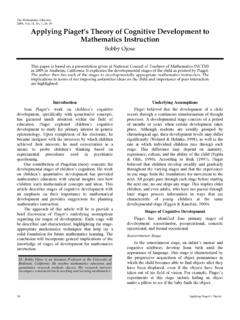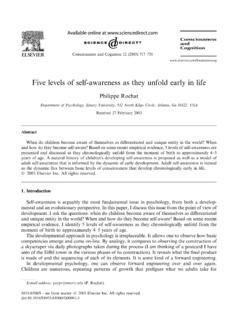Transcription of Session 2 Learning As We Grow: Development and Learning I ...
1 The Learning Classroom- 31 - Session 2 Session 2 Learning As We Grow: Development and LearningDeveloped by Linda Darling-Hammond, Suzanne Orcutt, and Melissa Cheung With Contributions From James Comer, University School of EducationI. Key Questions and Learning ObjectivesKey Questions How do children develop and learn? How can teachers support students Development and Learning ? Learning Objectives Pathways for Development Teachers will understand that students develop along several developmentalpathways, all of which interact and play a part in students Learning . Teachers will learn how they can enhancelearning by observing their students and supporting their Development across these pathways. Developmental progression Teachers will understand that Development progresses sequentially, thatteaching is more effective when it is appropriate to students developmental stages and within their zonesof proximal Development , and that Development can be supported by teaching.
2 Assessing and supporting readiness Teachers will begin to recognize students developmental signs ofreadiness across the different pathways. Teachers will understand the need to assess students current levelsof skill and understanding to make decisions about what students are ready to learn and how they can bestbe 2- 32 -The Learning ClassroomAs a teacher, you are really an instrument of Learning . You can help the child grow in all the develop -mental pathways. That growth is what makes academic Learning most possible. If you understand this,you will find all kinds of opportunities to help children grow and develop and learn what it takes to besuccessful in school and as an adult. James P.
3 Comer, (2001) children s growth and Development occurs across several interrelated yet distinct domains, including physical,mental, social, emotional, and moral. Two important themes are central to understanding children s progressthrough their developmental stages. First, physical, cognitive, emotional, and social changes are all occurringsimultaneously. Although these arenas develop simultaneously, they do not necessarily develop in tandem. Achild may be very advanced in his cognitive Development , for example, but less mature in terms of social devel-opment and may need more assistance in this , all of the internal changes that children and adolescents experience at their important transition pointsare mirrored by profound changes in their peer, school, and family lives.
4 Understanding Development requires notonly a consideration of the whole child, but also the whole child developing in particular social contexts. Thesecontexts and Learning environments influence cognitive reasoning, social and emotional Learning , personality andidentity Development , and moral PathwaysTo understand and support the Development and Learning of her students, a teacher must be able to take a devel-opmental perspective. This includes understanding that children move through several stages or sequences ofdevelopment (discussed below) and that they develop through several pathways of Development . These path-ways include: physical, social-interactive, emotional, psychological, cognitive, linguistic, and moral-ethical.
5 Withineach pathway, teachers must recognize how children vary across and within ages, how social and cultural contextsshape these different pathways in different ways, how these pathways interact and influence one another; andfinally, the implications these pathways have for instruction. Teachers who teach from a developmental perspec-tive strive to help children continually progress in each of these physical pathway refers to the body s biological Development , including the Development of the brain, motorskills, and coordination. These physical changes influence students Learning , thinking, and performance. Forexample, Learning to read involves biological Development as well as cognitive Development .
6 children s visualabilities (including binocularity and tracking) must mature before they can comfortably focus on and track smallprint. These abilities are generally acquired sometime between the ages of four and eight, often around age six orseven. At that point, children also have a well-developed sense of one-to-one correspondence and can compre-hend abstract symbols, making decoding of text easier (Cole & Cole, 1993, p. 476). Similarly, fine motor develop -ment is essential as students learn to hold and manipulate small objects, a precursor to Learning to social-interactive pathway refers to children s increasing ability to communicate and interact with a varietyof people in different social situations. It also refers to the ability to be empathetic, to know how to act appropri-ately according to social expectations, and to appreciate differences in people.
7 Social abilities develop over timeand are shaped by the social and cultural contexts in which children live. For example, in some cultures childrenare taught to interact freely with adults and to ask and answer questions. In others, such interactions are viewedas inappropriate. In some cultures, opinions are expressed directly. In others, such expression is impolite. Teachersneed to understand that social norms are learned and that social skills must often be explicitly taught, rather thanassumed. When children s behavior differs from classroom norms or expectations, it is important for teachers toexplain the desired behavior to children and model it for them rather than merely punishing them. For example,if a student interrupts a classroom discussion, the teacher can model active listening skills and specific strategiesfor gaining attention and speaking so that students can take turns expressing their emotional pathway refers to the child s growing ability to recognize, respond to, and manage feelings what some might call the Development of emotional intelligence.
8 [See Session 5, Emotions and Learning .] Supporting children s emotional Development involves helping students become skilled in recognizing andII. Session OverviewThe Learning Classroom- 33 - Session 2understanding their own and others emotions, learn how to express their feelings and concerns, and handle frus-trations productively. These abilities will support their ability to persevere in the face of difficulties and solve prob-lems as they arise without losing control or giving up. Emotionally supportive classrooms also help children to feelsafe so that they can learn effectively, because anxiety impedes the ability to focus and cognitive pathway refers to how information is processed, assimilated, and used in an increasingly sophisti-cated manner as children develop .
9 Over time and with support, children develop abilities to generalize from infor-mation, to manipulate information, to act on their environment and to learn from it. [See Session 3, CognitiveProcessing.) Although cognitive Development is progressive and has certain common milestones, children reachthese milestones at different ages depending on the Learning experiences they have had and what is valued andnurtured within their social context. Differences in cognitive Development are also related to individual differ-ences in how people process information and on the various strengths and intelligences they exhibit. [See Session 4, Multiple Intelligences.] Teachers need to be able to evaluate students levels of cognitive developmentin different domains, how they best process information, and their areas of strength in order to structure learningexperiences, pace instruction, and provide information in ways that children can best understand linguistic pathway refers to children s abilities both to receive communications and to express themselves.]
10 Tohelp children develop their linguistic abilities, teachers need to understand how language is acquired. They alsoneed to understand the structure of the language in which the child is expected to function, how social and cul-tural contexts affects language acquisition and Development , and how language Development is related to cog-nitive Development . The linguistic abilities children develop in their native language serve as a foundation forliteracy and Learning in school, including in a second language (Fillmore & Snow, 2000). This has application forteachers of English-language learners to help children acquire the literacy skills they need to succeed in psychological pathway refers to the Development of a sense of self, including feelings of adequacy, self-worth, and competence, as well as a sense of identity.
